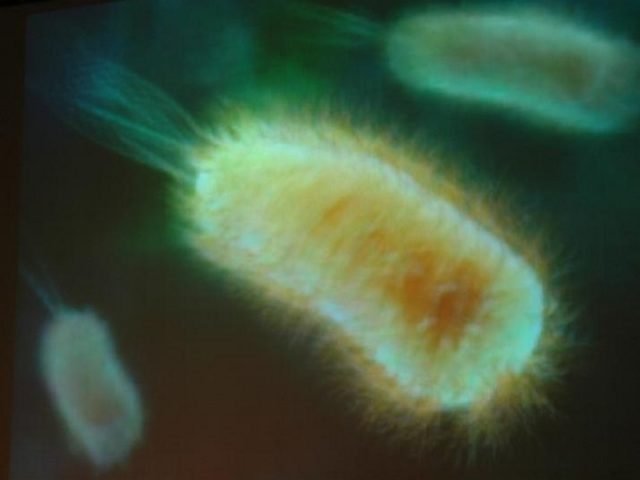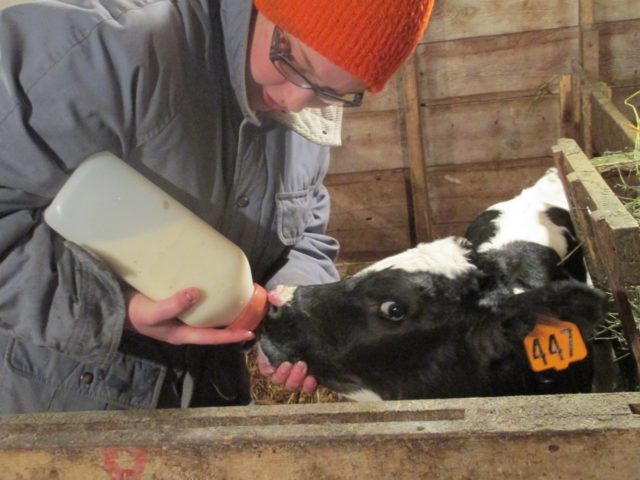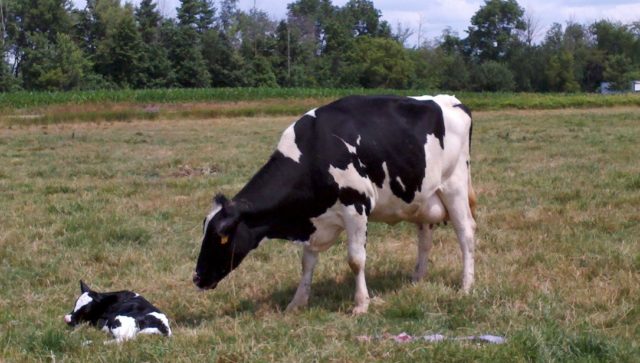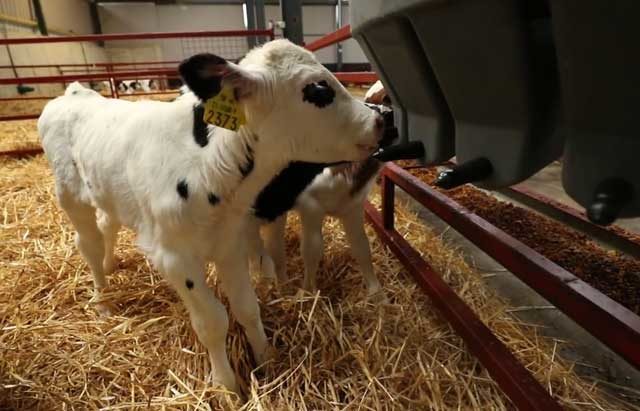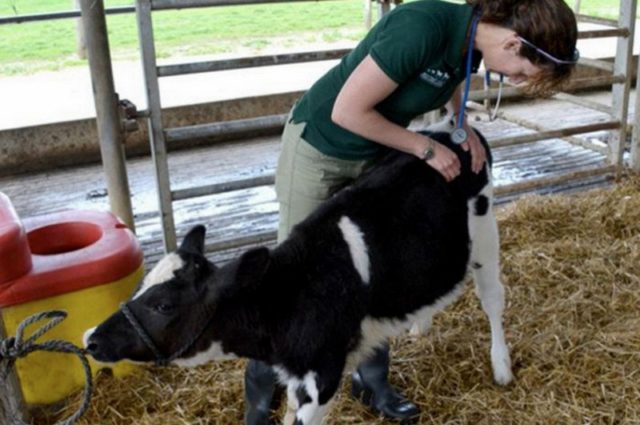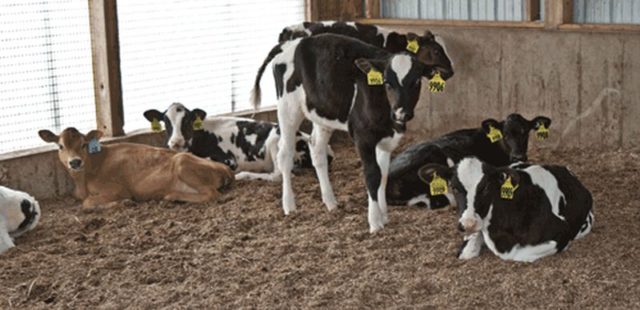Content
Colibacillosis in calves is caused by microorganisms that live in the intestines of cattle. The disease has another name - Escherichiosis of calves. It is characterized by severe dehydration, general intoxication of the young body of the calf, after which death often occurs. The disease can overtake cows in adulthood. An individual who has undergone colibacillosis becomes a carrier of this infection. However, dairy calves under the age of one week, as well as animals with weakened immunity, are most often exposed to escherichiosis.
What is colibacillosis
Colibacillosis is an acute infectious disease of the gastrointestinal tract of young animals. It occurs in the first days after the birth of a calf, and has different forms of manifestation. It is characterized by the ingestion of pathogenic E. coli species, which have invasive properties. Escherichia (Escherichia coli) can enter the calf's body through dirty udders, milk, which contains the causative agent. A sick newborn calf excretes microorganisms in the urine, feces into the external environment. Thus, all young animals on the farm can get colibacillosis.
For the first time, colibacillosis was identified at the beginning of the 19th century. Professor Obich has established that this disease is contagious and dangerous for the entire livestock. The disease was called white diarrhea in suckers. Further, it was determined that colibacillosis has different forms of manifestation. In the twentieth century, research was continued by such veterinary specialists as Vishnevsky, Mikhin, Tsven and others. They discovered serotypes, developed methods of treatment and prevention of colibacillosis.
The causative agent of colibacillosis in calves and cows are pathogenic strains of E. coli. They are classified as gram-negative anaerobic microorganisms that are capable of producing toxins. It is they that cause dysbiosis in the calf's body, inflammation of the intestines, stomach and other digestive organs, as well as lymph nodes. E. coli are not resistant to environmental changes. When boiled, they die instantly, in hot water up to 60 ° C - after 15-20 minutes. In the ground, in a humid environment, they can live for 3-4 months. Of disinfectants, bleach, phenol and formalin act on the causative agents of colibacillosis. The rest of the disinfectants are not as effective.
The disease has several stages: acute, subacute and hyperacute. In addition, in terms of localization, colibacillosis can occur in three forms:
- enteric - a rather mild form in which bacteria inhabit the mucous membrane of the small intestine of the calf, while releasing endotoxin;
- the enterotoxic form of colibacillosis develops when microorganisms attach to the epithelium, releasing exotoxin, which disrupts intestinal motility and impedes the elimination of harmful substances;
- the septic form is the most difficult, since the pathogen enters the blood, lymph.
With any of these forms of manifestation of colibacillosis, immediate veterinary care will be required, otherwise the disease will be fatal.
Colibacillosis is widespread. Basically, outbreaks of the disease are recorded during the calving season - in winter and spring.Most often, cattle are susceptible to infections with the stall method of keeping. An epidemic of colibacillosis occurs with the appearance of the causative agent of the disease when the maximum concentration is reached and in the presence of infection routes for the further spread of the infection. Experienced farm owners fight colibacillosis in calves with a special vaccine.
Causes of Escherichiosis in calves
Like all other infectious diseases of the gastrointestinal tract, colibacillosis is transmitted by the fecal-oral route. Sources of the disease can be:
- non-observance of sanitary and hygienic rules by farm personnel;
- contaminated feed, contaminated water;
- milk, colostrum from a sick cow, which is a carrier of colibacillosis;
- dirty udder;
- stale litter, dirty inventory;
- lack of timely vaccination of calves;
- urine, faeces of infected animals.
In addition, there are a number of factors that negatively affect the development of the disease. These include poor conditions for keeping cattle, inadequate, unbalanced nutrition of animals, poor quality feed, lack of vitamins and microelements in the diet. An important factor is the genetic predisposition of the calf to colibacillosis.
Symptoms of colibacillosis in calves
The clinical manifestations of the disease depend on the course of colibacillosis, as well as on the age of the calf.
The subacute course of infection is more typical for the enteric form of the development of the disease. Calves born more than a week ago usually get sick. They develop diarrhea, their general condition worsens, and conjunctivitis develops. Most of the time they spend lying down, some instability is noticeable when moving. Often, animals develop complications: pathologies of the knee and hock joints, rapid breathing, nasal discharge.
In newborn calves under the age of one week, colibacillosis occurs in an acute form. Babies have foaming diarrhea, no appetite, and the general condition is weak. In the feces, traces of blood, mucus, and colostrum clots are noticeable. Temperatures can rise to 41-42 ° C. The abdomen of the calf is distended, the mucous membranes are pale, and all signs of dehydration are present. But with timely treatment of colibacillosis, the prognosis is favorable.
The mortality rate of calves with hyperacute development of colibacillosis reaches almost 100%. The disease manifests itself in the first three days of the animal's life. It is characterized by a rise in temperature, rapid exhaustion. The calves are lying down, no appetite. Within a few days, they die from sepsis.
The enteric form of the disease is characterized by:
- persistent diarrhea;
- there is blood and mucus in the feces;
- dehydration, exhaustion;
- sunken sides, eyelids.
The septic form of colibacillosis manifests itself:
- general oppression of the calf's condition;
- increased heart rate, breathing;
- an increase in temperature;
- diarrhea is not observed.
Sometimes colibacillosis occurs in a mixed form. In this case, all symptoms manifest themselves simultaneously to a greater or lesser extent.
Diagnosis of escherichiosis in cattle
An accurate diagnosis is made on the basis of laboratory tests. They include biological, serological, bacteriological and microscopic diagnostic methods. Feces from the rectum or after stool are taken from calves for analysis. In the laboratory, the strain is determined and after that, drug therapy is started.
The microscopic method allows you to recognize the causative agent of colibacillosis in a colored and unstained state using a microscope. A biological or experimental method of research artificially reproduces the clinical picture of infection in laboratory animals and allows you to identify the pathogen. Serological identification of a microorganism is based on the determination of antibodies and antigens using reactions. Bacteriological studies, which take place in several stages, reveal a pure culture of bacteria.
The diagnosis of colibacillosis is considered established in the following cases:
- when isolating a pure culture of Escherichia, no less than from two organs or tissues (blood, bone marrow, spleen, heart), without determining their pathogenicity for mice or chickens;
- isolation from the test material of Escherichia with 1-2 types of antigens;
- discharge from the material of Escherichia, which belong to pathogenic serogroups.
Treatment of colibacillosis in cattle
Once an accurate diagnosis has been made, the calf should be treated immediately. Veterinary specialists use bacteriophage, gamma globulin, and hyperimmune serum against colibacillosis in calves. Of the antibiotics, the most effective are levomycin, biomycin, gentamicin and some other drugs. Symptomatic remedies are prescribed to remove toxins from the calf's body. In addition, it is necessary to replenish the loss of vitamins, minerals and fluids.
First of all, the sick calf must be isolated from the mother, transferred to a separate room. Instead of milk as a nutrient, you should give your baby saline solution with a raw chicken egg. Antibiotics are diluted with water before use, drunk strictly by the clock several times a day.
Camphor oil, caffeine is injected subcutaneously with severe depletion of the calf. The serum is also applied only subcutaneously. After neutralizing the contents of the stomach with a water-saline solution, a bacteriophage is administered orally. To remove toxins from the body and restore the intestinal microflora, you need to put a calf enema. After treating colibacillosis with antibiotics, the calf should be given probiotics, such as bifidumbacterin or enterobifidin.
Infusions and decoctions strengthen the calf's immune system, inhibit the growth of harmful bacteria, and improve the function of the gastrointestinal tract. However, they can be used as adjunctive therapy after consultation with a specialist.
Therefore, the treatment of colibacillosis should be comprehensive. Only then will the therapy be effective and give the expected result.
In addition to medication, the calf must be on a strict diet from the moment the disease begins. It is important to take care of restoring the water-salt balance in the baby's body, as well as neutralizing the effects of toxins. You will need to replenish the loss of fluid and energy. Calves who have recovered from colibacillosis should be introduced to feed vitamin supplements, microelements. After treatment, it is recommended to closely monitor the general condition of the calf and its stool. It is necessary to transfer the animal to its usual diet gradually, without loading the mucous membrane of the stomach and intestines.
Pathological changes in colibacillosis in calves
The corpse of an animal that died from colibacillosis is characterized by general exhaustion, sunken sides, and thin limbs. The wool of the calf is dull, in the area of the anus it is stained with feces, the skin is inflamed. The subacute form of colibacillosis is accompanied by damage to the respiratory system. In addition, the following changes are observed:
- hemorrhagic inflammation in the large intestine;
- swelling of the joints;
- inflammation of the walls of the stomach with hemorrhages;
- swelling of the veins;
- damage to the mucous membranes of the eyes;
- the gallbladder is full and distended;
- inflammation of the lymph nodes;
- dystrophic changes in the myocardium;
- enlargement of the spleen;
- signs of anemia in the liver, kidneys, mucous membranes.
At autopsy, the specialist notes traces of coagulated milk in the abomasum, remnants of undigested food with mucus in the intestines. Multiple hemorrhages are visible on the peritoneum.
Prevention of colibacillosis in young farm animals
To prevent colibacillosis in calves, a complex of preventive measures should be taken on the farm. The most important thing that a cattle owner must do is to carry out a mandatory two-time vaccination a month before the calving of the cow. Calving should take place in a clean environment. Newborn calves should be left with their mother for a day and then placed in a special disinfected box. All calves on the farm must be kept in a separate room and do not allow young animals to come into contact with adults.
Other preventive measures include:
- compliance with all basic sanitary and hygienic standards in the barn;
- cleanliness of service personnel and care items;
- during calving, the calf should be taken in fresh straw or burlap;
- full feeding of a pregnant cow;
- vitamins and minerals in the diet;
- regular cleaning and disinfection of the barn;
- separate room for the hotel.
In the first hours after calving, the newborn calf must be given colostrum to form strong immunity and develop its own microflora.
Of the vaccines and serums that are used for the treatment and prevention of colibacillosis in calves, the following drugs have proven themselves well:
- multivalent vaccine, which is used before and after calving;
- polyvalent serum - fed to calves in accordance with age;
- coliprotectan VIEV - the calf is administered orally once after birth;
- bacteriophage - diluted with water and given to calves at the age of 1-4 months.
The correct treatment regimen can only be determined by a veterinarian. In the farm where a sick animal is found, it is necessary to carry out all sanitary and veterinary measures. Sick calves are isolated from the herd to avoid mass contamination. If there is a suspicion of infection, animals should be treated with bacteriophage or hyperimmune serum. When breeding cattle, you need to observe the standards of care and maintenance, with the slightest change in behavior, you must immediately contact a veterinarian to find out the reasons for this condition.
Conclusion
Colibacillosis in calves is rather difficult, since the first days of life are dangerous for animals. The infection is manifested by severe dehydration, rapid exhaustion, intoxication of the body, complications from the nervous system. Therefore, when the first symptoms of the disease appear, you need to invite a veterinarian and follow his instructions. You should not try to treat the individual on your own, as this disease threatens the life of the animal. Colibacillosis is best prevented, so the owner needs to vaccinate the animals in a timely manner and take care that the infection does not spread to the entire herd.
